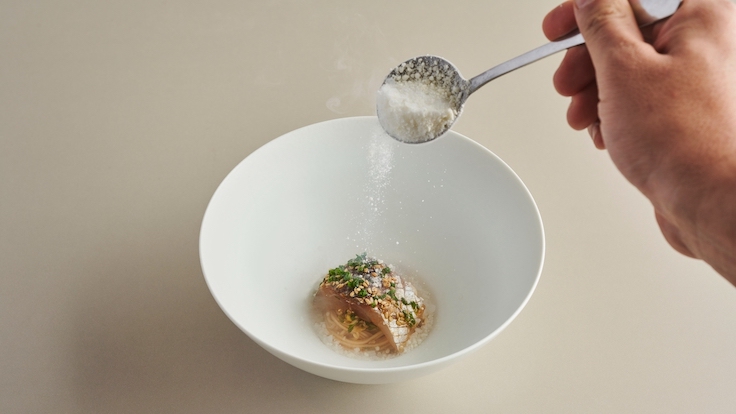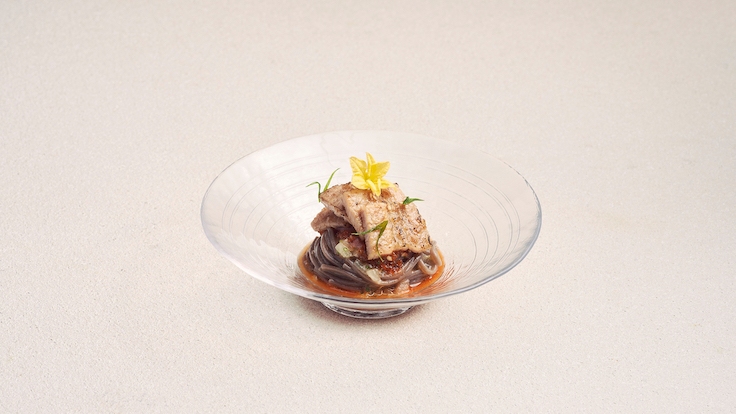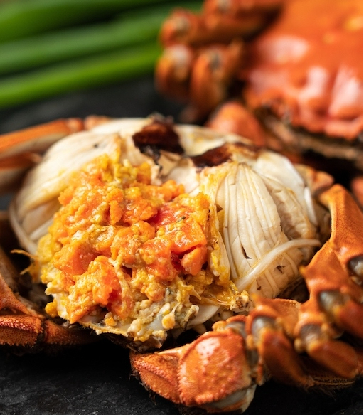Usually served chilled and made with thin, delicate wheat noodles (somyeon) and a clear broth, Korean cold noodles (naengmyeon being one of the more popular types) are especially enjoyed in the summer. Traditionally served with thinly sliced meat, vegetables, and a boiled egg, the dish is also garnished with sesame seeds and other toppings.
Having been an integral part of Korean cuisine for centuries now, there are many types of Korean cold noodles, and the origins of this noodle style trace back to the southern part of the Korean peninsula. In the earlier days, preparing Korean cold noodles was a practical and convenient way for using excess grains and vegetables, while providing nourishment for farmers and field workers during the hot and humid months.
Even today, a bowl of cold noodle soup remains a staple and iconic Korean dish that is enjoyed for both its light flavour and health benefits. In Singapore, MICHELIN-Starred Korean restaurant chefs Sun Kim of Meta and Louis Han of Nae:um get creative and serve their own unique and refined versions of Korean cold noodles in their restaurant's respective menus. Here's how they do it.

The Tradition of Korean Cold Noodles
"Naengmyeon literally means 'cold noodles' in English," explains Kim. "It's usually made with beef stock and served with sliced beef, pears, and buckwheat noodles. However, there are actually many types of cold noodle dishes in Korea, depending on the region. For example, in Busan, where I grew up, there is a cold noodle dish called milmyeon. Instead of buckwheat noodles, milmyeon is served with flour noodles, which are quite unique when served with a cold broth. Some regions in Korea also use pheasant stock or kimchi juice instead of beef."
Han shares that summers can be especially hot in Korea, and people usually dive into bowls of cold noodles to feel refreshed. "In the old days, noodles were difficult to make because flour was a rare ingredient to source in Korea. Hence, Koreans used buckwheat and potato starch as substitutes to flour in order to make noodles. Due to its difficult preparation, noodles of all types were considered a luxury dish that can only be enjoyed by the nobles. Historically, noodle dishes originated in the Goryo dynasty, and cold noodles only became more accessible to the public during the Joseon dynasty," he shares. "If you were to watch sageuk (Korean historical dramas), you will see the actors representing the common people salivate over noodle dishes — it is not simply a comic exaggeration!" Han says with a laugh.

Fond Memories with Korean Cold Noodles
For Kim (pictured on the left), cold noodles were a vehicle to bringing his team together after the busy weekend service rush. "I love to cook cold noodles for my staff meal at Meta," he shares. "I used to make it every Saturday night after dinner service. We would all sit together and enjoy the noodles after a busy week."
Kim also expresses that Korean cold noodles are a must-have at Korean barbecue restaurants. "When I have a family gathering, cold noodles are always my number one pick at the restaurant. It's the best way to finish a heavy meal."
One way that Kim enjoys his Korean cold noodles is by mixing them with a spicy soup. "I usually order both and mix them together to share with the people I'm dining with. This is the best way to enjoy naengmyeon for me," Kim shares.
When Han thinks of cold noodles, it is the memory of his mother that comes to mind. "My mum was a working mother, so she only had time to cook for the family on Sundays," he shares. "Cold kimchi noodles were her specialty, and this became a Sunday family tradition. I really loved her cold kimchi noodles, and I found our Sunday family time so special because of her cooking. So, when I opened Nae:um, I wanted to make my own version of a cold kimchi noodle dish, too, so that everyone can enjoy it."
The Perfect Korean Cold Noodles
As shared by Kim, his preferred Korean cold noodles contain a kick of spice in the broth. "I prefer the noodles to be served very, very cold... and spicy!" he says. "At Meta, we serve handmade noodles with a gochujang-based spicy sauce, homemade kimchi, perilla leaves, sliced seasonal fish, and kimchi juice that we turn into snow."

"At Nae:um, we call our cold noodle dish "Somyeon" because my mum used wheat noodles for her cold kimchi noodles," says Han. "Nae:um's cold noodle dish uses buckwheat noodles, and we make our own kimchi that we turn into the noodles' dressing. It's so refreshing!"
When cooking the noodles, Han explains that everything is timed to the very last second. The noodles are immediately rinsed with cold water to give them their bouncy texture. "We ensure that all the water is drained out so that the noodles can absorb our kimchi dressing better as well," he shares.

"If you want to make cold noodles at home, I recommend that you find toppings that you like, and eat them with the noodles in one bite," Han says. Both Han and Kim share the same sentiment that cold noodles are especially great with freshly grilled meats. "The cooling effect of the noodles feels so nice after a heavy meal. This is why naengmyeon will always be a popular a menu item in Korean barbecue restaurants."
Speaking of pairing grilled meats and cold noodles, the toppings of Nae:um's Somyeon change depending on the menu, and this season, the restaurant celebrates the spirit of Front Yard Barbecue. "We are currently serving our Somyeon with grilled black pork belly — exactly in the spirit of that K-BBQ and naengmyeon combo. So far, our diners have been really enjoying this version!" Han shares excitedly.
Meta is located at 1 Keong Saik Road, 089109, Singapore; and Nae:um is located at 161 Telok Ayer Street, 068615, Singapore. Make a booking for Meta here and for Nae:um here.






















